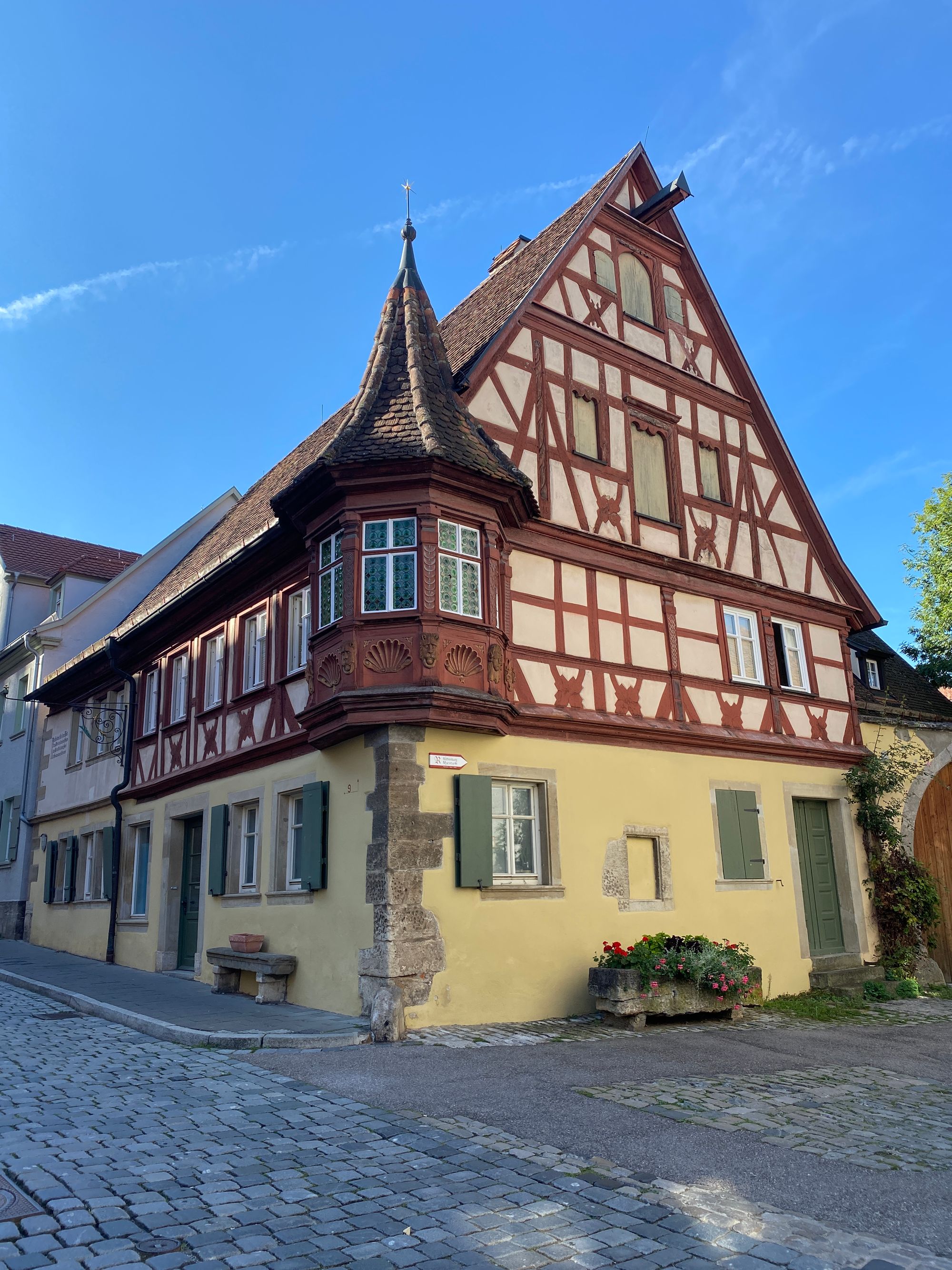Red Fortress Above the Tauber River
That’s what the name of this town means. And indeed, the red roofs of this picturesque little town sit atop a hill like a colorful hat, encircled by a sturdy, lace-like wall stretching 4 kilometers, dating all the way back to the 13th century.

This wall has seen it all: periods of war and peace, bustling times of a booming wool trade, and the town's golden era as a Free Imperial City under the Holy Roman Emperor. Back then, Rothenburg was one of the largest cities in Germany. It also witnessed darker times, such as the infamous Jewish massacre of 1298, the devastation of the Thirty Years’ War (1618–1648), the plague, the town’s decline, and eventually, its renaissance in the 19th century. Even the 20th century left its mark: during World War II, parts of the wall were destroyed in 1945 when Allied forces bombed Nazi supply lines, inadvertently striking parts of Rothenburg.
Rothenburg’s history is a testament to triumph, hardship, and resilience. It also serves as an inspiring example of what can be achieved when people of different origins and faiths unite for a common purpose. After World War II, individuals and organizations worldwide donated funds to restore the historic wall, enabling us today to walk atop it, marveling at the red rooftops and retracing the steps of medieval watchmen.
Pilgrims and Pathways
Since the 9th century, the famous Camino de Santiago has led pilgrims through Rothenburg on their way to the shrine of Saint James in Santiago de Compostela, Spain. It seems the local tourism industry has been thriving for quite some time! Even today, Rothenburg offers plenty of pilgrim-friendly accommodations. The Camino de Santiago has become increasingly popular, not just among religious pilgrims but also among hikers and spiritual seekers of all kinds.

One of Rothenburg’s iconic landmarks is a statue of Saint James, the patron saint of pilgrims, located near St. Jakob’s Church—a fitting nod to its long history of welcoming wanderers.
Fairytale Streets
Rothenburg ob der Tauber is one of the best-preserved medieval towns in Germany. Many of its colorful houses were built between the 13th and 16th centuries, lending it a storybook charm.
If you’re an anime or movie fan, you might find some scenes familiar. Rothenburg served as a backdrop for films like Howl’s Moving Castle and Willy Wonka & the Chocolate Factory,among others.







Did You Know?
In medieval times, those iconic half-timbered houses weren’t brightly painted. That trend began later when homeowners started painting their homes to showcase their wealth and prosperity. The practical side? Before street numbers became common in the 18th century, house colors made it easier to give directions—“the red house by the square,” for instance. That’s why older houses are so colorful, while modern city homes tend to be, well, dull and uniform.

Schneeballen: A Local Treat
Like many Franconian towns, Rothenburg has its own culinary specialty. But surprise—it’s not bratwurst or beer! Instead, it’s a dessert.
Sweet Schneeballen (or snowballs) have been a Rothenburg specialty for at least three centuries. These fist-sized, snowball-shaped pastries are made by layering strips of thin dough, forming them into balls, and deep-frying them until golden brown. They remind me of Middle Eastern desserts made with thin fried dough and sweetened with powdered sugar or icing. Could Schneeballen have been inspired by treats brought here by Eastern traders or pilgrims? It is likely, but no one can tell for sure.


As the bakery owner explained, Schneeballen are traditionally cracked open with a special wooden hammer. Lacking one of those (what a pity!), we resorted to simply pulling apart the crispy layers with our hands and biting into the sweet, flaky deliciousness. Note to self: next time, pack the hammer in my purse—just in case. What? Are you laughing at me? I’m serious! For now, my travel purse already includes my trusty set of lightweight titanium utensils: fork, spoon, and knife. Why? Because I can’t stand disposable cutlery for two very good reasons. First, they’re wasteful—you use them once and then toss them, littering our planet in the process. And second, they’re maddeningly useless: plastic forks tend to snap before you even finish your meal, and don’t get me started on knives that can’t cut a thing.
The Christmas Village
Don’t miss the Christmas Village shop in Rothenburg’s historic quarter! This charming store looks small from the outside, but as any Doctor Who fan knows, it’s bigger on the inside.
We wandered in, partly out of curiosity and partly to hunt for souvenirs. Before we knew it, we were meandering down split levels and staircases, surrounded by a forest of Christmas trees, Santa villages, rows of ornaments, angels, snowmen, cards, toys, and games. Honestly, the only thing that stopped me from grabbing everything I liked was the size of my carry-on bag. Next time, though? Watch out.

A Perfect Getaway
Rothenburg ob der Tauber is an ideal destination for one or two days: not too big, not too small, but just the right mix of cozy, historic, and picturesque. It’s a place where fairytales meet real history—and maybe a little bit of indulgence, too.




